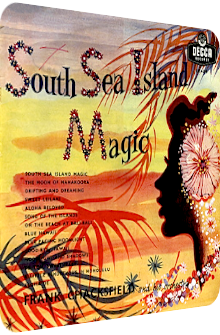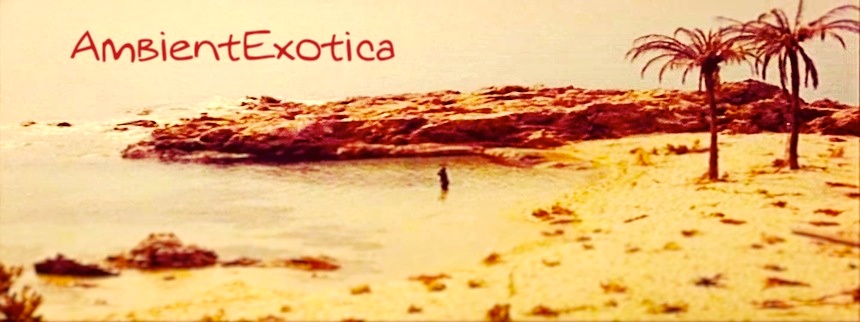
Frank Chacksfield
South Sea Island Magic
1958
How strange that Exotica takes off in 1958 and many a Hawaiian album is created in the process as well. Whether you see the genre alloy of Exotica and the Hawaiian tradition of Hapa Haole music as distinct forces or entangled entities, once a trend is materializing, rest assured that record labels are all over it, asking their in-house composers and combos to come up with standards to fulfill the needs of the crowd. In the case of composer and conductor Frank Chacksfield (1914–1995) and his Polynesian 14-track epitome South Sea Island Magic, the reason is again provided and fueled by Hollywood which transforms the famous musical South Pacific by Richard Rodgers and Oscar Hammerstein II into a Technicolor flick of way over two hours of tinted lenses, thiazide vignettes and a gorgeous cinematography whose verdured jungles and isles remain vivid to this day.
When the folks of Decca Records approach Chacksfield to come up with an aural artifact of similar magic, South Sea Island Magic is created. Featuring a large string orchestra with occasional brass undercurrents, vibraphone splashes, woodwinds and golden harps, the album harbors well-known Hawaiian classics and some less known counterpoints, all of them exuding the moony atmosphere of the islands. Is there anything wrong with such an approach? No, not with the approach itself, but rather with the streamlined cohesion that lacks surprises. South Sea Island Magic is twinkling to the masses, reluctant to offer really twisted arrangements or utterly enchanting Space-Age strings. However, it is still more than good enough to be featured in-depth, with some of its songs being gorgeous entities after all.
The kick-off of this album is crucial, lest the fan of symphonic Exotica surrenders to Les Baxter once and for all. I obviously exaggerate. All the better that the eponymous title track can stand on its own feet. Penned by Andy Iona Long and Lysle Tomerlin, South Sea Island Magic features gorgeous harp helixes, Polynesian flutes and majestic strings that ignite the impression of listening to a Latin ensemble. However, soon enough the lilac Space-Age hue comes into play, surrounding the cosmic – instead of earthbound – steel guitar in the epicenter. The polyphony of the flutes round off a paradisiac tune which is succeeded by Alfred Newman’s and Frank Loesser’s dreamy standard Moon Of Manakoora, envisioned here via long phases of double bass-accentuated placidity, whirling strings and flugelhorn backdrops, before Drifting And Dreaming by Egbert Van Alstyne and Erwin Schmidt boost the fairy tale aura via vibraphone-alloyed pizzicato strings and mellifluous flute tones, in fact as much so that it has been considered by The Avalanches for their sample fest Since I Left You (2000).
Harry Owens’ Hapa Haole standard Sweet Leilani meanwhile relies on a comparatively tame and orderly played steel guitar in the string-encapsulated epicenter, whereas Andy Iona Long’s and Ray Canfield’s Aloha Beloved is a lovelorn ballad with great pineapple riffs and flute entanglements amid fragile quiescence. Afterwards, Charles E. King’s Song Of The Islands offers another titration of symphonic strings and autochthonous steel guitar prowess before the less-considered On The Beach At Bali-Bali by Abner Silver, Al Sherman and Jack Meskill closes side A with a comical Waltz made of effulgent flutes, exhilarative harps and vibe vesicles.
Side B is no different, an adage I retell quite often when it comes to Exotica and its similar genres and niches. When Leo Robin and Ralph Rainger are named in the same sentence, it is most often due to their gold standard Blue Hawaii. Frank Chacksfield’s arrangement however disappoints and is too reliant on the classic strings, with only a bumping double bass serving as the pulsating aorta. Jack Payne’s and Wallace Herbert’s Blue Pacific Moonlight is on the wrong side of the spectrum during its infancy stage due to the overly chintzy lead fiddle, but the second part with its viscid vibes and vivid harps turns things around and offers a nocturnal will-o-the-wisp. Up next is a tune that isn’t sitting in the correct place: Good-Bye, Hawaii by Harry Leon and Leo Towers is presented right in the middle of side B, but for a change puts the aureate brass layers into the foreground. Since the strings are quite screechy, the lure is alas not everlasting.
Moonlight And Shadows by Friedrich Hollaender and Leo Robin is a success though, launching with tawny midnight strings, moving over to magenta counterparts until the alto flute solo anticipates the near end. Harry Owens’ second piece To You, Sweetheart, Aloha is presented here in the shape of superfluid flutes, steel guitar stopovers and – for the first time – an transparent ukulele accompaniment. Edgar Leslie and Joe Burke are considered as well with their besotted A Little Rendezvous In Honolulu and its horn-heavy hexangular intercommunication with pointillistic piano prongs, but eventually have to make room for the mandatory inclusion of Queen Lydia Liliuokalani’s Aloha Oe. You’ve heard it before: steel guitar plays lead melody. Strings provide both the bouquet and bokeh. It’s nothing out of the ordinary… for better or worse.
Frank Chacksfield’s South Sea Island Magic is a hit-or-miss affair when it comes to two different things: the encapsulation of Hapa Haole’s true spirit, and the planned plastic imagery of the transmogrified Space-Age view onto the subject. After all, there are many string-heavy albums by like-minded artists and composers to choose from, be it Les Baxter’s magnificent Caribbean Moonlight (1957), George Cates’ Polynesian Percussion (1958) or Werner Müller’s partially schlocky Hawaiian Swing (1962). Chacksfield’s work differs in that it elbows away the omnipresence of Hawaii’s primary stringed instruments – steel guitar and ukulele, probably not in that order – in favor of the magic of strings. Since the tone sequences and famous melodies are always intact, the result is a blending of compromises: neither is the devoted fan of these old classics shied away, nor is the final result over the top and too outlandish. It is an Easy Listening album after all.
What I don’t get, however, is the underused instrumental pool, for the orchestra is larger than one expects. The pianist, for instance, only appears on A Little Rendezvous In Honolulu, and while I equally embrace the fact that the piano does not appear on all tracks, it is strange that this instrument only happens to appear in one singular instance. I don’t know what such a discovery ultimately proves, whether it’s missed opportunities or the willfully ascetic passing, but South Sea Island Magic is a nice inessential addition to the collector’s shelf nonetheless. It is available on vinyl, on CD where it is coupled with Chacksfield’s fabulous In The Mystic East (1957), and as a digital download.
Exotica Review 434: Frank Chacksfield – South Sea Island Magic (1958). Originally published on May 23, 2015 at AmbientExotica.com.
